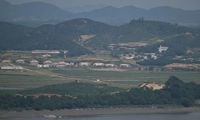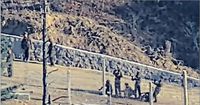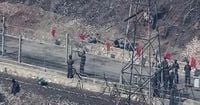Tensions on the Korean Peninsula have flared once again following a dramatic incident along the heavily fortified border separating North and South Korea. On August 19, 2025, South Korean soldiers fired more than 10 warning shots with 12.7mm machine guns toward North Korean troops who were engaged in constructing a barrier near the southern border, according to multiple reports from KCNA, Yonhap, and AFP. The episode has ignited a fresh war of words between Pyongyang and Seoul, raising concerns about the stability of the region at a time when large-scale military exercises are already underway.
North Korea was quick to respond. On August 22, 2025, Ko Jong-chol, Deputy Chief of the General Staff of the North Korean People’s Army, issued a stern statement through the state-run KCNA, calling on South Korea to “stop provocative actions that are purposeful and planned.” He described the incident as a “very serious initial development” that could push the border situation to the brink of being uncontrollable. “This is a very serious initial development and will surely make the situation at the border uncontrollable. There is a large number of opposing troops in the area,” Ko warned, as reported by KCNA.
According to North Korean officials, the soldiers targeted by the warning shots were working on what Pyongyang calls a "permanent blockade barrier project" along the southern border. North Korea claims this initiative is intended to strengthen and permanently close the border, a move that follows leader Kim Jong-un’s late-2023 declaration that inter-Korean relations have devolved into those of “two hostile countries.” Since April 2024, North Korean forces have been seen installing barbed wire and various barriers near the Military Demarcation Line (MDL), the de facto border between the two Koreas, according to Yonhap and Reuters.
North Korean authorities insist that their activities are non-military in nature and have been conducted with transparency. Ko Jong-chol emphasized that Pyongyang had notified U.S. forces stationed in South Korea about the construction plans on June 25 and July 18, 2025, in an effort to avoid misunderstandings or accidental conflict. “We informed the U.S. forces about this project in advance to prevent any unintended clashes near the border,” Ko stated. The U.S. reportedly viewed this notification as a “sincere tension reduction measure” and confirmed the project was being carried out on North Korean territory, according to KCNA.
However, Ko Jong-chol accused South Korea of escalating tensions through “malicious and increasingly large-scale” provocations, despite these efforts at transparency. “Provocative actions causing tension against our soldiers continue, and are becoming more malicious and larger in scale,” he said. He further warned that North Korea would respond to any obstruction or interference with the barrier project with “appropriate countermeasures.” “If acts of obstruction or interference with this non-military project continue, we will consider them deliberate military provocations and will take corresponding countermeasures,” Ko declared, as reported by KCNA. North Korea also made it clear that they would not be responsible for any serious consequences if their warnings were ignored in the future.
South Korea’s Joint Chiefs of Staff (JCS) provided their own account of the events. According to the JCS, the warning shots were fired after some North Korean soldiers crossed the MDL while working in the Demilitarized Zone (DMZ) on August 19. “Measures such as warning shots were taken after North Korean soldiers violated the MDL at around 3 p.m. on August 19. They subsequently retreated north,” a JCS official told Yonhap. The JCS added that South Korean forces continue to closely monitor North Korean military activities near the border.
This incident is not without precedent. Earlier in April 2025, South Korean troops fired warning shots at a group of 10 North Korean soldiers who crossed south of the MDL; those soldiers promptly withdrew. The context of these repeated encounters is important: In October 2024, North Korea announced the complete closure of its border with the South and detonated road and railway links connecting the two countries, as confirmed by Reuters and KCNA.
The latest border clash comes at a particularly sensitive moment. The annual Ulchi Freedom Shield joint military exercise between South Korea and the United States began in early August 2025 and is scheduled to last 11 days. North Korea has long criticized these drills as provocative and aggressive, calling the current exercise “an extremely provocative and hostile act aimed at Pyongyang,” according to KCNA. In contrast, U.S. and South Korean officials maintain that the exercises are purely defensive in nature, designed to bolster readiness and deter potential aggression.
Adding to the complexity, the North Korean statement stands in stark contrast to recent remarks from South Korean President Lee Jae-myung. Just last week, President Lee had announced plans to scale back some military activities along the border as part of a renewed effort to improve inter-Korean relations. The timing of the warning shots and the subsequent accusations from Pyongyang have cast a shadow over these diplomatic overtures.
As of now, neither South Korea nor the United States has issued a formal response to North Korea’s latest accusations or threats. Both governments have remained tight-lipped, perhaps wary of further inflaming an already volatile situation. Meanwhile, North Korea has doubled down on its rhetoric, warning that any further attempts to obstruct its border barrier project will be met with decisive action.
Observers note that the Korean border remains one of the world’s most dangerous flashpoints, where misunderstandings or miscalculations can quickly spiral into crisis. The construction of new barriers, the exchange of warning shots, and the ongoing military exercises all contribute to a climate of suspicion and brinkmanship that shows little sign of abating.
As the Ulchi Freedom Shield drills continue and both sides maintain heightened alertness, the world watches anxiously. The incident is a stark reminder of how swiftly tensions can escalate along the Korean Peninsula, even amid efforts—however tentative—to find common ground. For now, the border remains as tense as ever, with both North and South Korea seemingly digging in for the long haul.


